Aug 2013
Aug 2013 sadmin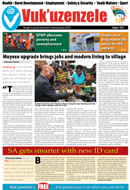
Learnership Invitation
Learnership Invitation sadmin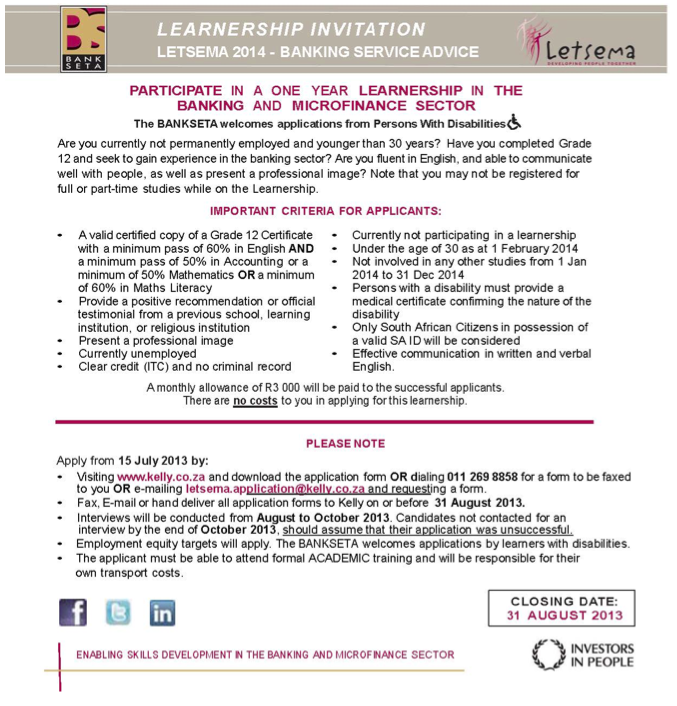
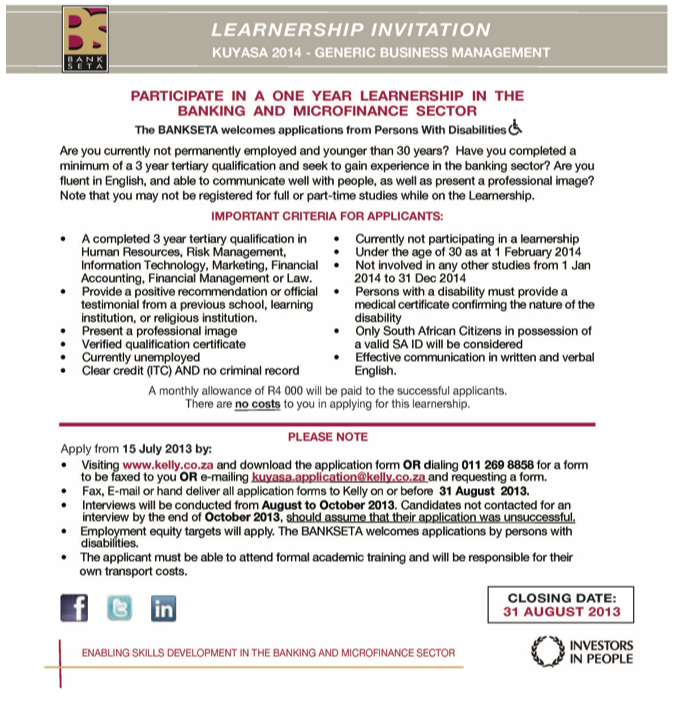
Muyexe upgrade brings jobs and modern living to village
Muyexe upgrade brings jobs and modern living to village sadminLeading up to the 2010 FIFA World Cup™, Virginia Simango from Muyexe Village near Giyani was unemployed and dependent on her husband.
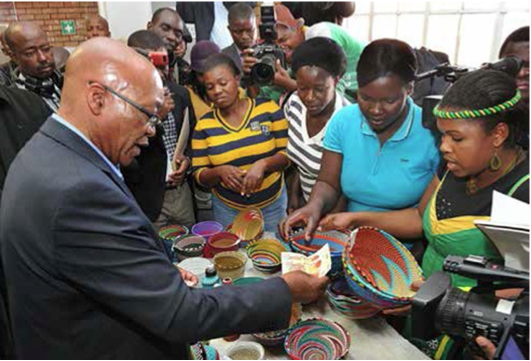 Things were hard at home. My husband and I have two girls, one was 16 years old at the time and the other was eight.
Things were hard at home. My husband and I have two girls, one was 16 years old at the time and the other was eight.
So because I was unemployed, we relied on my husband’s salary. He works at a factory in Germiston.”
But her fortunes changed in 2010 when she met an official from the Department of Rural Development and Land Reform who helped her and over 150 other women from the village to make a living from arts and crafts.
With training from the department, the women were ready to knit beads that decorated vuvuzelas in time for the World Cup. The vuvuzelas were sold for R120 each.
Simango is one of many who are benefiting from the Comprehensive Rural Development Programme (CRDP) that President Jacob Zuma launched after his State of The Nation Address in 2009.
The programme was piloted at Muyexe Village and soon, the Department of Rural Development and Land Reform will take it to other rural areas around the country.
President Zuma recently visited the village, some 30 kilometres from Giyani to assess the progress of the programme and the impact it has had on the village – which has about 1 000 households with a population of 4 500 people.
Simango, who was exhibiting her handmade bowls and beaded water bottles, told President Zuma that she and eight other women have been in business since 2010 and that government secures invitations for them to exhibit their work once or three times a month, depending on how busy it is.
Her next goal is to have her company, Progress Muyexe Arts and Crafts, registered so that she can conduct business formally and establish a flea market.
President Zuma went on a shopping spree, buying five large decorating bowls that Simango and her colleagues made out of straw, for R600. Her crafts were popular on the day, and she made off with R1 360.
A three-room mobile office has since been delivered to Simango for her and others to craft their artworks from. Simango and her eight colleagues will be part of an arts and crafts cooperative that Rural Development is setting up. Currently, 150 residents are involved in arts and crafts in Muyexe.
Simango said she was happy to have met President Zuma, and said ever since his visit, officials had been in constant contact with her and she has been assured that she will be helped with the registration of her company.
“While we appreciate the Government’s help in getting us exhibitions, having a registered company will enable us to stand on our own and seek our own place to market our work,” she said.
President Zuma also visited three other projects in Muyexe – the Muyexe Early Childhood Development Centre that houses orphaned children, the Muyexe Macena Garden and the Muyexe Water Purification Plant and Reservoir.
President Zuma said he was very happy with the progress that had been made since the programme was launched.
We are looking forward to taking this programme to other areas. The Minister of Land Reform and Rural Development has said that this project has taught us several lessons that we will use when we go to other rural areas.”
As part of the programme, about 330 houses are being built, boreholes have been equipped, a water purification plant has been set up underwritten by the Development Bank of South Africa, internal water reticulation has been established by the Giyani local municipality and 275 sanitation units have been provided.
A community centre which houses a Post Office, a clinic, a satellite police station, a drop-in centre and a sports stadium has also been built by the provincial government.
The local school was renovated and more classrooms and ablution facilities were added. A new Early Childhood Development Centre with solar lighting was also constructed.
Two village viewing areas now enable the community to view major sporting events. Also, an I-school Africa Rural Development Programme at the primary and secondary schools offers learners an opportunity hone skills in the use of new technology.
Charles Neluheni, a Deputy Director at the Limpopo Department of Rural Development and Land Reform, said since the programme was launched in 2009, 1 498 temporary jobs had been created.
Moshe Swartz, rural development’s deputy director-general, said the department supports several cooperatives.
The Macena women’s garden is one of the eight cooperatives that the department was helping. Other cooperatives are into fence making, brick-laying, arts and crafts, bakery, poultry and perfumes respectively.
Swartz said young people in the area will be recruited to join the National Rural Youth Service Corps, a programme to uplift unemployed youths in rural areas.
SA gets smarter with new ID card
SA gets smarter with new ID card sadminThe Department of Home Affairs has started issuing the new smart ID cards, giving priority to former Presidents and other stalwarts of the liberation struggle.
But it will take about eight years for everybody to get the card. Home Affairs Minister, Naledi Pandor explained that the card has good security features, including materials which prevent tampering. Personalisation with laser engraving of personal details and photographs makes the new card extremely difficult to forge or tamper with.
The new card will take less time to produce than the green barcoded identity document. It is estimated that the card will take five to 10 days to produce, a marked improvement on the 49 days it takes to produce the ID book.
In issuing the card, the department has prioritized senior citizens of the Nelson Mandela generation – those of 80 to 90 years of age. They were issued with their smart cards on 18 July - Nelson Mandela Day. The new card will now be given to first-time applicants and people who have lost their ID documents at offices that have the capacity to issue the new cards.
“In order to avoid a rush, applicants will be invited to our offices in stages, according to their dates of birth.
“We appeal to everyone to be patient and to allow us to phase in this change efficiently. We will work hard to expand the number of offices able to process applications for the Smart Card ID,” said Minister Pandor.
This month, the department will honour the women who led the heroic march against the pass laws in 1956. “On Women’s Day, August 9, we will commission four machines to produce the Smart Card IDs. They will be named after Helen Joseph, Lilian Ngoyi, Sophie de Bruyn and Rahima Moosa in honour of the brave and selfl women who led the Women’s March on the Union Buildings on 9 August 1956,” Minister Pandor said. Each machine has the capacity to produce 1 000 cards an hour and they work 24 hours a day. The department spent R40 million on the machines.
The department started by using two offices in the Western Cape and another in Gauteng to process applications for the Smart Card ID. By the end of August, the department is expected to have 27 offices around the country able to process ap- plication of the Smart Card ID. The cur- rent green barcoded ID document will be phased out over time as more people get the Smart Card ID.
Public Works opens doors for young South Africans
Public Works opens doors for young South Africans sadminInfrastructure
Before 2010, Ntomboxolo Mbeqezi was just one of many unemployed youth in Colesberg township in the Northern Cape, battling to take care of her child.
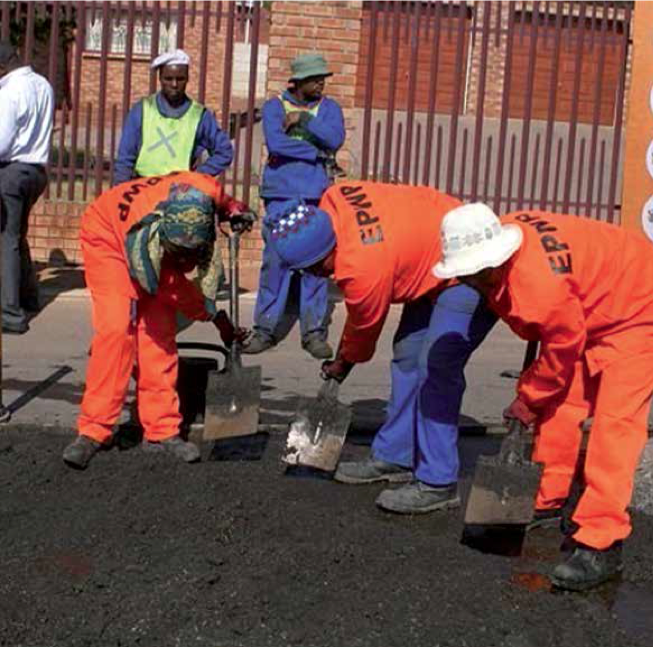 But her life changed when she was recruited along with 11 others, to train as an artisan at the Umsombomvu Mu- nicipality under the Expanded Public Works Programme (EPWP), and things started looking up. In 2011, the trainees were taken to the South African Nuclear Energy Corporation in Pretoria where they underwent a one-year apprenticeship as artisan fitters.
But her life changed when she was recruited along with 11 others, to train as an artisan at the Umsombomvu Mu- nicipality under the Expanded Public Works Programme (EPWP), and things started looking up. In 2011, the trainees were taken to the South African Nuclear Energy Corporation in Pretoria where they underwent a one-year apprenticeship as artisan fitters.
Today, Mbeqezi is placed as a contract worker at an Eskom Power Station in Witbank. “It feels good to be working. I get to travel and see places. It’s a dream come true for me. I always wanted to be an artisan.”
The EPWP enabled her to acquire skills and experience, giving her an entry point into the job market.
Since 2009, the programme has created more than three million of these work opportunities. EPWP Deputy Director-General Stanley Henderson said the target for the second phase, running from 2009 to March 2014, was to create 4,5 million work opportunities for unemployed South Africans.
“Since the implementation of the EPWP Phase 2 in 2009, the programme has made a significant impact within our South African communities in the upliftment of the socio-economic conditions of the unemployed.
“By the end of the 2012/13 financial year, 3,1 million work opportunities have been created since the start of the second phase,” he said.
Henderson said this achievement positioned the programme as one of the key catalysts in government’s job creation drive.
He also said the incentive grant model was revised by the Public Works Department to give rural municipalities easier access to grants, in order to increase labour intensive work opportunities through the EPWP projects.
The revised model was implemented last year. “The programme easily reached its target for participating women and youth, with 60% of the participants being women and 50% being youth, compared to the targets of 55% women and 40% youth,” he said.
More municipalities are implementing EPWP, with 277 out of 278 municipalities having already signed agreements committing them- selves to achieve their EPWP targets.
Henderson also announced that the department was in the process of finalising a business plan for Phase 3, adding that the proposal would be submitted to Cabinet Lekgotla for endorsement.
The department also unveiled the EPWP website, which will be used to promote the programme, make it accessible and transparent to beneficiaries and all the relevant stakeholders. The EPWP was introduced in 2004 to alleviate poverty and unemployment by providing training and work opportunities to the poor and unemployed South Africans.
All three levels of government implement it across its four sectors, which are infrastructure, non-state, environment and culture as well as the social sector.
With the skills she has acquired, Mbeqezi says she can now look for a permanent job with more confidence.
For more information visit: http://www.epwp.gov.za
New infrastructure to provide water to communities
New infrastructure to provide water to communities sadminInfrastructure
The launch of two multi-billion rand water and sanitation projects at the Vaal Dam has set in motion a major infrastructure development drive that is expected to create thousands of jobs and resolve service delivery backlogs in Gauteng.
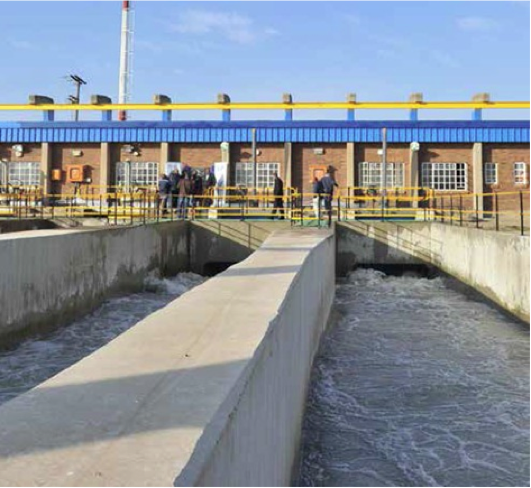 The Vaal Dam is South Africa’s second biggest dam by area situated on the outskirts of Vereeniging south of Johannesburg.
The Vaal Dam is South Africa’s second biggest dam by area situated on the outskirts of Vereeniging south of Johannesburg.
The first project, a R5-billion Sedibeng Regional Sewer Scheme, will anchor the Strategic Integrated Project (SIP) 18 – a water and sanitation infrastructure programme.
When the Minister of Water and Environ- mental Affairs, Ms Edna Molewa, launched the programme at the Vaal Dam recently, she said the programme would go a long way in resolving water and sanitation problems, especially in poorly serviced or un-serviced areas.
“This programme, in simple terms, is a 10-year plan that will address the estimated backlog of adequate water to 1,4 million households and that of basic sanitation to 2,1 million households.
“The recent Green Drop Report indicates that of the 914 water supply systems assessed, 41% require attention. Similarly, 55% of 821 wastewater treatment works require serious, critical and urgent refurbishment.”
The Sedibeng Regional Sewer Scheme will see the construction of a new Waste Water Treatment Works to increase sanitation capacity in the area.
The second project is Rand Water’s BG3 pipeline, the largest water pipeline in Sub- Saharan Africa, which runs from the Vaal Dam to its Zoekfontein Plant 8,6 km away.
The pipeline will increase water distribution in and around the area. “I am pleased that the BG3 pipeline will not only increase raw water capacity to Zuikerbosch by up to 2100 Ml/d, which will accommodate the region’s growth water demand projected to 2030, but because it duplicates the BG2 (existing line), it will allow the BG2 to be taken out of service for crucially needed maintenance or renovation works,” said Minister Molewa.
SIP 18 is expected to fast-track the issuing of water licenses, expand the water system capacity, speed up build programmes, address backlog projects and rehabilitate and upgrade existing water and sanitation infrastructure in the next 10 years.
Single-dose drug makes life easier for HIV patients
Single-dose drug makes life easier for HIV patients sadminThree months after the roll-out of the Fixed Dose Combination (FDC) antiretroviral pill, patients at the Dr George Mukhari hospital in Ga-Rankuwa are happy with the new wonder drug and are complying with treatment.

HIV-positive patients on FDC take only one pill a day as opposed to two doses of three to four drugs a day.
Principal Specialist in Obstetrics and Gynecology at the hospital Dr Tshililo Mashamba says patients are saying the FDC is wonderful because they do not have to carry pills around during the day. “They say they can continue with their normal duties of the day and not worry about taking any pills.”
Dr Mashamba says the hospital had 61 patients who were started on the FDC in May, and 29 in June. “We start with pregnant patients who are newly infected by HIV. There are those who were receiving AZT in line with previous guidelines because their CD4 count was 350 or less. They qualify to be on the pill, changing from AZT to the FDC drug.” A patient who is not responding well to the three-ARV pill combination can also be moved to the FDC if the constituencies contained in those ARVs are not the same, explains Dr Mashamba.
But he admits that a few patients have suffered side effects from the new drug. “They complain of vomiting, dizziness and being drowsy as the only side effect they experience.” According to Dr Mashamba, people who are on ARVs at the hospital are mainly in the 18 to 34 age group. “We also get a wide variety of patients who are pregnant and HIV positive. Some as young as 14 and others as old as 45.”
Health Minister Dr Aaron Motsoaledi launched the FDC in April at Phedisong 4 Community Health Clinic in Ga-Rankuwa. The pill is expected to improve compliance by reducing the risk of patients defaulting on treatment.
Dr Mashamba explains that if a patient de- faults on the medication, the virus in the body will develop resistance and the medication may not work when restarted. “When this happens we have to do resistance testing at microbiology labs. That is why it is important for patients to take their medication as prescribed.”
The FDC contains emtricitabine, efavirenz and tenofovir a multiple ARV drug combined into a single pill, which helps reduce the pill burden.
Dr Mashamba, who is part of the team of medical staff that administers the FDC at the hospital, says when the Health Minister announced that there would be a single pill, everyone on ARV treatment wanted the pill. “In fact they were demanding it. They were not aware of the guidelines that we as health professionals have to follow when administering the drug.”
He says as part of the guidelines given by the Department of Health, if a patient is responding well to three of the fi ARVs and the infection is well controlled, they should not be changed.
Breastfeeding makes your baby healthier
Breastfeeding makes your baby healthier sadminBreast milk contains important nutrients and is one of the most effective ways to ensure the healthy physical and mental development of your baby.
 It also contains antibodies that help to protect against dangerous illnesses, including the two most common causes of infant mortality worldwide – diarrhea and pneumonia. Breastfeeding also has long-term benefits for your baby. Evidence suggests that adults who were breastfed as infants often have lower blood pressure and lower cholesterol, as well as lower rates of obesity and type-2 diabetes.
It also contains antibodies that help to protect against dangerous illnesses, including the two most common causes of infant mortality worldwide – diarrhea and pneumonia. Breastfeeding also has long-term benefits for your baby. Evidence suggests that adults who were breastfed as infants often have lower blood pressure and lower cholesterol, as well as lower rates of obesity and type-2 diabetes.
Breastfeeding may help to reduce the risk of breast and ovarian cancer for the mother in later life. It has been shown to assist with weight loss after pregnancy, which can be helpful in adjusting to life with a baby. Many women also consider breastfeeding to be a special time of bonding with their child and an experience that both mother and baby can share together.
The World Health Organization advises that you should breastfeed for six months following the birth of your baby, before introducing other sources of nutrition. It is important to start breastfeeding within the fi hour of birth if possible, as this is when the mother's body produces colostrum, a thick and creamy liquid that is high in nutrients and is easily digestible for babies. Colostrum encourages the clearing of the baby's intestines, which helps to prevent jaundice.
While breastfeeding can be a wonderful experience, some women may find that it causes their nipples to become a little sore or cracked. To ease the pain, try feeding your baby with both breasts equally and allow the milk ducts to empty completely to avoid swelling.
You must also keep your nipples dry between feeds by changing your bra pads often. Don’t use perfumed creams or soaps as these can make dry and cracked nipples worse.
Some women may fi that they are not able to breastfeed. This may be as a result of oestrogen-containing birth control pills, illnesses or hormonal disorders and breast surgery. For these mothers formula is the best option. However, when using formula it is of the utmost importance that you wash the bottle and its rubber teat with clean water and that you sterilise them completely before feeding your baby the formula. You must also be sure that the water you are using to mix with the powdered formula is clean and safe for your baby to drink.
If I am HIV positive, can my baby get HIV from my breast milk?
Approximately 15% of children become infected with HIV from their mothers through breastfeeding, according to the United Nations Children's Fund (Unicef). However, antiretroviral (ARV) drug therapy in either the mother or HIV-exposed baby can significantly reduce the risk of transmission through breastfeeding.
It is important for HIV-positive mothers who are breastfeeding not to give their children any other liquids and/or foods, as studies have shown that exclusive breastfeeding for up to six months can lead to a significantly reduced risk of transmission. Studies have shown that certain factors in breast milk can directly fight cells that contribute to HIV transmission. Women who are HIV-positive and pregnant or with infants should consult a healthcare professional about the feeding options available to them and to discuss possible AVR therapy.
World Breastfeeding Week runs from 1 to 7 August.
Mature learners discover the joys of reading
Mature learners discover the joys of reading sadmin“The feeling I get from seeing an elderly person being able to read for the fi time, is indescribable. This is the reason why I became a teacher,” says Ntombozi Mabhe.
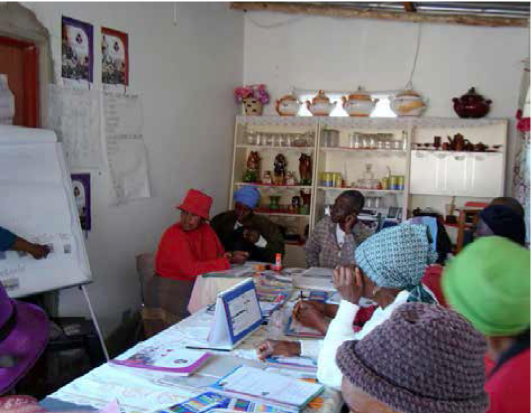 Mabhe is a volunteer educator, working with adult learners in the Qumbu District of the Eastern Cape as part of the Kha ri Gude programme.
Mabhe is a volunteer educator, working with adult learners in the Qumbu District of the Eastern Cape as part of the Kha ri Gude programme.
“Seeing the joy on their faces as they attend school for the first time, is priceless. They are now able to read, write and count, giving them a newfound sense of freedom to be able to read their bibles and use their cellphones. I am proud to have contributed to this,” adds Mabhe.
Until recently, the adult learners in Mabhe’s class could not read or write because they had never been to school. It is only now, that they are parents or grandparents, that the Kha ri Gude programme has offered them the chance to go to school for the fi time, proving that you are never too old to learn to read and write.
The Kha ri Gude campaign run by the Department of Basic Education has made it possible for them to discover the joys of reading. Since 2008, more than 2.9 million adult learners across the country have gone through the programme, and they can now read and write in their vernacular and some in English as well.
The campaign is well on track to meet its goal of halving illiteracy by 2015 by reaching and teaching 4.7 million South Africans to read and write in one of the 11 official languages. The campaign has increased its intake from 357 195 learners in 2008 to 665 246 in 2012. It is also projected that the campaign will reach a further 676 800 by the end of the year, another 677 980 next year and another estimated 677 980 by 2015.
Kha ri Gude is Tshivenda for “Let us learn". The mass literacy campaign is helping to boost the confidence and restore the dignity of many.
Another proud teacher, Khethiwe Komazi, is a vibrant 21 year old from Kimberly who has her own special way of teaching prison inmates, while successfully keeping them focused to their school work. Komazi is a volunteer educator of the Kha ri Gude programme and teaches prison inmates Afrikaans, English and Numeracy. Komazi’s learners are between the ages of 16 and 65, and she says she enjoys working with elderly people. “At first I was intimidated by working in a prison, however, once I got to know the offenders I became comfortable with teaching, as they each have interesting stories to tell.”
The class material is specifically designed and uses themes and life-skills such as health, gender, the environment and civic education to teach learners. This material has also been adapted for use in Braille, the 11 official languages, and by the deaf.
Volunteers in each province are selected and are given job opportunities to teach in classes. Over the past few years, the campaign has paid out R750 million to more than 70 000 volunteers.
The classes are held in homes, churches, mosques, schools, prisons and community centres, and are free of charge.
At the end of the programme, learners who have demonstrated that they are able to master the basic skills of reading and writing are presented with certificates which are the equivalent of Adult Basic Education and Training Level 1 certificates. This certificate will enable those who are interested to further their education up to ABET Level 4, which is the equivalent of Grade 9.
To find out more on how you can enrol or be a volunteer teacher in your community contact the Kha ri Gude call centre on 0800 20 29 33.
The doors of tertiary learning open wider
The doors of tertiary learning open wider sadminFor Sphume Ndlovu, the excitement of passing matric in 2004 was dampened by the knowledge that he did not have money to study further.
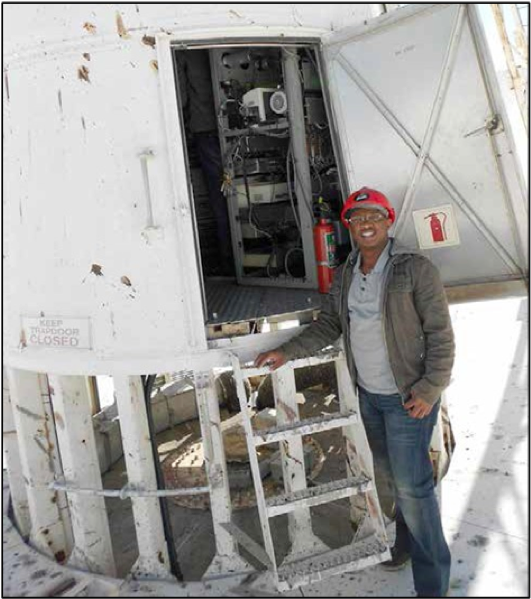 Raised by a single mother who sold chickens in Landskop Pietermaritzburg for a living, tertiary education appeared out of reach for him.
Raised by a single mother who sold chickens in Landskop Pietermaritzburg for a living, tertiary education appeared out of reach for him.
Although he had a distinction in Mathematics plus some Cs and Ds for other subjects, which included physical science, biology and accounting, Ndlovu spent 2005 idling at home.
It was only with financial aid from the University of KwaZulu-Natal and National Student Financial Aid Scheme of South Africa (NSFAS) that Ndlovu managed to study for his Bachelor of Science, majoring in Applied Mathematics and Physics. Today, the 26-year-old PhD student is a Researcher at the Hartebeesthoek Radio Astronomy Observatory (HartRAO) located west of Johannesburg.
“I always thought that if you wanted to go to university your family needed to have money or get a bursary. I was not aware that there was something called NSFAS”
With more students from disadvantaged backgrounds, like Ndlovu, managing to access tertiary education, the number of graduates has increased significantly in recent years.
Addressing Parliament, Minister of Higher Education Blade Nzimande said the number of Engineering Sciences graduates had increased from 8424 in 2009 to 9387 in 2011, Natural and Physical Science graduates increased from 3468 in 2009 to 5526 in 2011, Human and Animal Science graduates increased from 7341 in 2009 to 8070 in 2011 and graduates in teacher education were up from 6315 in 2009 to 10361 in 2011.
“Data for 2011 indicates that in all scarce skills fields, African and female graduates were more than 50 per cent except in Engineering Sciences where female graduates were 26 per cent,” Minister Nzimande said.
A survey conducted by the South African Institute for Race Relations and published in 2012 indicates that the number of students enrolled at universities and universities of technology increased from 570 000 in 1995 to 886 633 in 2010, with the number of African students doubling – from 286 000 to 595 777 over the same period.
Before the demise of apartheid, black students were not allowed to study at established universities because of the 1959 Extension of University Education Act, except with the special permission of the education minister. Minister Nzimande said his department had introduced numerous strategies to improve graduate output in scarce skills areas. The Department of Higher Education plans to increase the number of students in tertiary institutions from the current level of 900 000 to 1.5 million by 2030. It has developed a number of strategies to enable more learners to enroll at tertiary institutions and to increase the capacity of these institutions.
NSFAS progress
In his Budget Vote speech, Minister Nzimande said NSFAS has been allocated R5.7 billion to give bursaries and loans to students at universities and at Further Education and Training colleges this year. According to the Minister, NSFAS has assisted 1.4 million students since 1991.
Ndlovu is grateful to NSFAS and the government for helping him pursue his education. “NSFAS works, I am very happy about my success.”
Jabulani: A homely jungle with a view
Jabulani: A homely jungle with a view sadminAt 62, pensioner Kattie Sibiya had given up hope of ever owning her own house. But then the Mpumalanga Department of Rural Development started building houses for people in her neighbourhood of Jabulani, 36 kilometres outside Piet Retief in Mpumalanga.
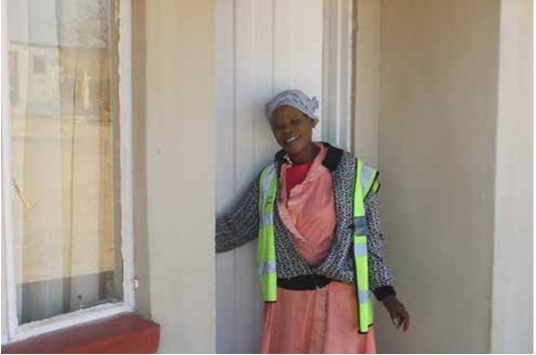 Sibiya’s fortunes changed when paper company Mondi and the Mpumalanga Government formed a private/public partnership to improve the lives of people living on Mondi property.
Sibiya’s fortunes changed when paper company Mondi and the Mpumalanga Government formed a private/public partnership to improve the lives of people living on Mondi property.
A delighted Sibiya said; “I was born in this area and grew up here. I never thought that I would own a house. Before, my family and I were living in a mud house that was very cold in winter and the roof leaked during the rainy season. I am very happy to finally own such a beautiful house.”
The drive from Piet Retief to Jabulani starts off smoothly on a tarred road. But as you approach Jabulani, you enter a mini forest, and with it, a gravel road.
For a second along the bumpy ride, you begin to wonder whether there is human life among the tall gum trees that dominate the landscape. Deep in the mini forest, the air is crisp and the view of rows upon rows of trees is breath taking. Nestled deep in the forest are rows of grey houses with green roofs. From here, you have a spectacular view of the Morgenstond Dam. Contractors are on site, giving shape to a new multi-purpose centre and renovating the local school.
Jabulani falls under the Mkhondo Municipality where about 80 000 hectares of land belonging to Mondi is situated. The full name of the village is Jabulani Bafazi, which means “women be happy”.
Spokesperson for the Mpumalanga Department of Human Settlement, Freddy Ngobe said 33 housing units have been built as part of the project.
“The units were funded by the Department of Rural Development as a pilot project of the Comprehensive Rural Development Programme (CRDP), which is being delivered at seven poverty-stricken municipalities including Mkhondo.
“The Provincial Department of Human Settlements was responsible for the facilitation of beneficiaries, monitoring and inspection of the project and preparing payment certificates for the Department of Rural Development.”
Ngobe said the houses cost the department R2 million.
The project is planned as a sustainable human settlement with social facilities such as a school, a community hall, a multipurpose centre sports facilities and worship sites.
The Department of Human Settlements built the houses and Mondi contributed top-up funding to enhance the houses into environmentally and thermally friendly living spaces with water-harvesting features, ceilings and roof finishes, said Maurice Makhathini who is the Head of Land at Mondi.
Sibiya is one in the fi batch of people to receive a house from the 33 units. She lives in a two-bedroom house with a kitchen, lounge and bathroom. She shares the house with her son and grandson.
Ngobe said the department would soon appoint a service provider to build 78 more units in the area.
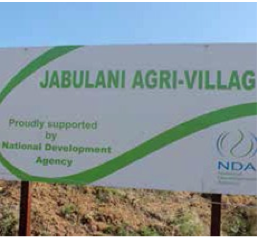 The idea of developing Jabulani followed a visit to the area by Mondi board members seven years ago.
The idea of developing Jabulani followed a visit to the area by Mondi board members seven years ago.
“A survey we conducted during 2007 and 2008 revealed that about 10 000 people arranged into about 3 500 households lived in 61 villages with minimal to no services, earning very low incomes and highly dependent on government grants,” said Makhathini.
Makhathini said when the company bought the farmland, there were people who had historically lived on the land and the company could not just remove them. “In 2008, Mondi approached the Office of the Premier in the province. The Premier immediately embraced the project. Mondi then signed a memorandum of understanding to develop the area with the Mpumalanga government, Umkhondo Municipality and the Gert Sibande District in 2009 to work together.”
The development of Jabulani is part of a pilot project, which would focus on decent housing, electricity, water, sanitation and creating opportunities for economic development in the area.
As part of upgrading the area, the local school, Thathukusa Primary School is being extended. The school had three classrooms where some grades were combined. The school will now have a stationery room, an office, two extra class- rooms and a hall. Adjacent to the school is the multipurpose centre site. The National Development Agency (NDA) sponsored the building of the multipurpose centre.
A funding application was submitted to the NDA in 2011 and approved in 2012 for a R3,2-million grant to build the multipurpose centre. The centre will house a kitchen, a community hall, offices, youth centre, adult centre and four stores.
When the development of the community was initiated, a legal entity in the form of a Communal Property Association (CPA) was formed to represent the interests of residents.
Chairperson of the CPA, Nhlanhla Nhlabathi expressed appreciation to government and Mondi for developing Jabulani and said the area has the potential to develop as a tourist destination.
Farmers in Luka find treasure in mushrooms
Farmers in Luka find treasure in mushrooms sadminFor over a decade, Peter Rammutla was an ordinary village cattle farmer battling to get by. But in 2008, he teamed up with five other people from Luka Village, outside Rustenburg to start the Kotulo Mushroom Cooperative.
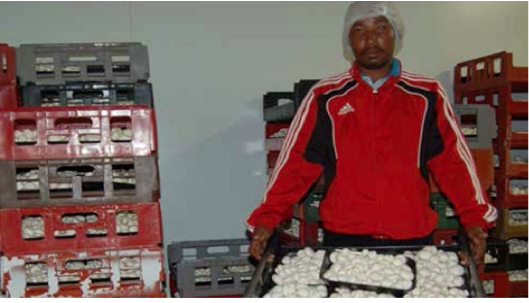 His interest in mushroom farming developed after he toured Tropical Mushrooms owned by Peter Nyathi in Magaliesburg. It then struck him that there were no mushroom farms in the Rustenburg region.
His interest in mushroom farming developed after he toured Tropical Mushrooms owned by Peter Nyathi in Magaliesburg. It then struck him that there were no mushroom farms in the Rustenburg region.
When it started, the cooperative had no money to build the special structure for growing mushrooms and to pay for electricity. It seemed to be living on borrowed time.
But in 2009, the North West Department of Agriculture and Rural Development came to the rescue. The department started by giving the cooperative R2,4 million, followed by a further R1,2 million in 2012 for the construction of the structure where the mushrooms are grown. The structure has six rooms of 180 square metres each fitted with shelves. The Small Enterprise Development Agency (Seda) helped the co-operative draw a production and marketing plan. Seda also helped to barcode and brand their products for the mass market.
Today, the cooperative supplies mush- rooms to big retailers such as Spar, Fruit and Veg City and Spur. “We do the delivery ourselves,” he added. The cooperative employs 16 people drawn from the village. “We import the soil we use to grow mushrooms from Ireland and The Netherlands every quarter, while the compost is ordered locally,” explained Rammutla who added that harvesting takes place after 18 days of growing.
The department took members for training in mushroom production and allocated them a project manager who is experienced in mushroom production. The department’s Agricultural Extension Advisor also provides technical support on a regular basis.
Rammutla said there is stiff competition in mushroom farming. “The competition is very tough. We are managing because we produce quality mushrooms and people love them.”
The MEC for Agriculture and Rural Development, Desbo Mohono, said the department would continue to support the cooperative because it is the only mushroom project funded by the department in the Province. The department helps the cooperative get access to niche markets, given its massive nature and contribution towards rural development.
The cooperative has established markets in and around Rustenburg and Gauteng. “We produce 2,5 tons per week and our produce has proved to be the best in the market as it is 100% organic,” said Rammutla.
Concerned police officer's boldness helps the deaf
Concerned police officer's boldness helps the deaf sadminAn intuitive police officer who felt frustrated when a deaf person could not get assistance to open a case at her police station came up with an idea that impressed her superiors.
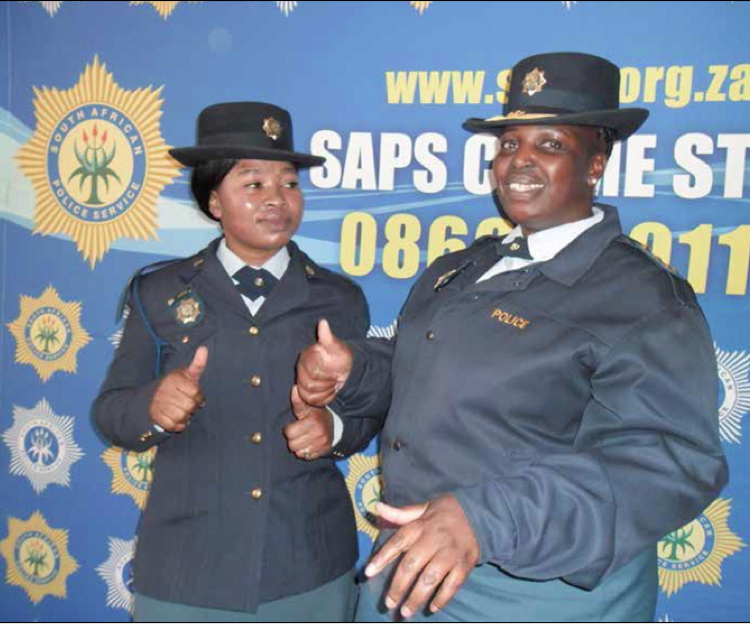 I felt very disappointed all the time because I had noticed that some clients didn’t get enough help because we didn’t know how to communicate with them,” said Constable Zanele Mtshali, from the Nelspruit Police Station in Mpumalanga.
I felt very disappointed all the time because I had noticed that some clients didn’t get enough help because we didn’t know how to communicate with them,” said Constable Zanele Mtshali, from the Nelspruit Police Station in Mpumalanga.
In May, Constable Mtshali approached her cluster leader, Brigadier Dorah Xaba, with the idea of getting police officers trained in sign language.
A month later, through her idea, more than 40 police officers from the South African Police Service Nelspruit Policing Cluster received Sign Language Basic Level certificates. “I am very happy that this idea didn’t just fall on the rocky ground but today I can see that deaf people are being assisted at different police stations under Brigadier Xaba's cluster,” she said.
Brigadier Xaba said helping crime victims get justice made it easy for her to understand Constable Mtshali's idea. “At first it was difficult for me to present the idea of establishing this helpful project in my cluster to my superior, Mpumalanga Police Commissioner Lieutenant General Thulani Ntobela, but as a woman of faith I went to his office the following day without even arranging a meeting with him first," said Brigadier Xaba. He added that Constable Mtshali's idea would improve policing in Mpumalanga and across the country.
During the handing over of the certificates, Lieutenant General Ntobela said the project, which was sponsored by insurance company Metropolitan, is the first of its kind in Mpumalanga. He promised that before the end of the year, all 82 police stations in the province would have police officers who understood sign language to help speed up the process of opening dockets for deaf people.
"From now on, all deaf or people living with any kind of disability in our province will have access to our police stations quickly because of you," said Ntobela.
Metropolitan Group Scheme's regional manager Kobus van Vuuren said that the insurance company would sponsor the project until April next year because it has been such a success. “I went to their class last week and spent an hour with them. There is a lot of progress.”
DEAF SA representatives in the office of the Premier welcomed the initiative.
“We are very happy to see this project. We will have officers in our stations who will interpret when we open dockets,” said DEAF SA member Patience Mbuyane.
She proposed that Commissioner Ntobela establish an SMS line for 10 111 so that deaf people can be able to report crime using text. “We also urge our Commissioner to make this language official in the province and to ensure it becomes language number 12 in theconstitution,” Ntobela said.
There is a new sheriff in town
There is a new sheriff in town sadminA passion for the law led Carry-Lee Seema from the Northern Cape to follow in her father’s footsteps and become a sheriff.
 Seema is one of the 71 new sheriffs recently appointed by the Department of Justice and Constitutional Development (DOJ&CD), to be deployed across the country. She is now a sheriff for the Koffiefontein, Jaggersfontein, Petrusburg and Fauresmith areas.
Seema is one of the 71 new sheriffs recently appointed by the Department of Justice and Constitutional Development (DOJ&CD), to be deployed across the country. She is now a sheriff for the Koffiefontein, Jaggersfontein, Petrusburg and Fauresmith areas.
The newly appointed sheriffs also reflect the demographics of the country in respect of race and gender, says Justice Spokesperson Mthunzi Mhaga. Of the 71 appointed sheriffs, 47 are African, 11 are White, seven are Indian and six are Coloured. Women represent 18 of the new appointees and men 53.
Announced by Minister of Justice, Jeff Radebe, the newly appointed sheriffs will fill vacant offices of sheriffs countrywide, raising the total number of sheriffs operating in the country to 365.
Mhaga says the role of sheriffs is critical to the functioning of the courts. “Sheriffs have an important role in the criminal justice system as they act as third party to serve court process and execute the warrants and orders of the court which are issued in terms of the Act and the regulations of the different Courts.”
Even though being a sheriff was not Seema’s first choice, it was definitely her passion, and after working as an Information Technology specialist for many years, her passion came knocking in 2010 when she moved to Bloemfontein.
“A sheriff is an impartial and independent official and is a messenger of the court. As a sheriff I constantly remind myself that the laws are necessary sanctions for the continued existence in society and I bear the responsibility to make sure they are upheld,” says Seema proudly.
Her father Archibald, who works as a sheriff in Kimberley, offered Seema a job as a receptionist. Eager to learn, she began reading all about the Supreme Court, Magistrates Court and the Sheriffs Acts. “It was my job to be well equipped with these Rules and Regulations,” she says.
The sheriffs will take up their new du- ties in October this year and are currently undergoing a mandatory induction training programme.
Through this programme, government is making significant strides to transform the Sheriffs profession in the country. The new appointments will enable the department to continue working hard to ensure that justice is accessible to all.
Groen Sebenza helps young people branch out
Groen Sebenza helps young people branch out sadminAfter graduating with a bachelor degree in Science and Zoology, Given Leballo spent two years without a job. From 2005 to 2007, the University of Pretoria graduate would wake up in the morning to buy newspapers and page through the Careers section looking for a job without success.
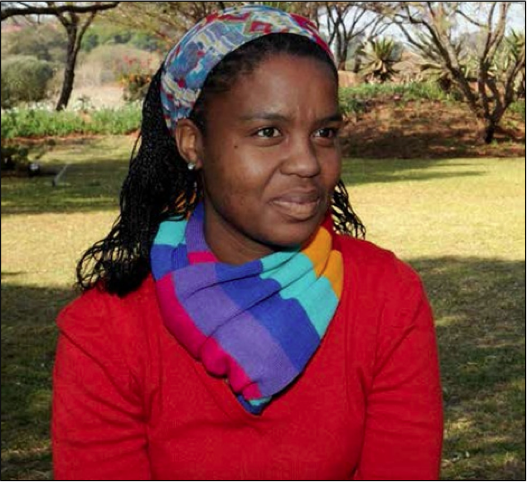 Leballo’s prayers were answered in 2008 when she got a job as a machine operator at the Nuclear Energy Corporation of South Africa (Necsa). She was one of the people responsible for extracting uranium at the Necsa plant, a job she did not like. “It was sad for me to do something that I did not study for,” she explains with a sad face.
Leballo’s prayers were answered in 2008 when she got a job as a machine operator at the Nuclear Energy Corporation of South Africa (Necsa). She was one of the people responsible for extracting uranium at the Necsa plant, a job she did not like. “It was sad for me to do something that I did not study for,” she explains with a sad face.
After spending four years at the plant, she decided to take the risk by resigning and looking for a job in the biodiversity sector, a field she studied and is comfortable with. Her timing was perfect because just at that time, the South African National Biodiversity Institute (SANBI) was looking to recruit 800 young people for a new project called Groen Sebenza.
Groen Sebenza is an initiative spearheaded by SANBI in partnership with 32 other stakeholders in the biodiversity sector. It aims to develop skills and bridge the gap between education and the workplace in the biodiversity sector. The R300 million project is sponsored by the Development Bank of Southern Africa’s Jobs Fund.
The initiative is based on an "incubator model" that gives 800 participating youth workplace experience through a mentor- ing programme. Participants are allocated mentors for the duration of the mentorship which runs for two and half years. Out of the 800 incubants, 500 are graduates and 300 are school leavers (matriculants).
Leballo is currently employed in the Biosys- tematics department of SANBI where she is responsible for maintaining the database of all the indigenous animals in the country. As a graduate, she earns R7100 and she says it goes a long way in supporting her two kids. “This really helps a lot and the fact that I’m doing what I studied for makes things even more simple,” she adds.
Programme Manager of Groen Sebenza Vivian Malema says that the training of the 800 learners will add skills that are badly needed in the biodiversity sector. “These incubants will serve as a catalyst to skills development in the sector.”
Who qualifies to apply?:
- Unemployed youth from previously disadvantaged backgrounds
- South African citizens
- Primary residence and schooling in rural areas
- 50/50 gender split
- A national matriculation certificate for the School leaver placement
- A national diploma or first B-degree for the Graduate placement
- A demonstrated and clearly articulated commitment to the environment
- A commitment to a career development in the environmental sector
- Good leadership potential.
For more information, contact SANBI at 0128435000 or visit the website www.sanbi.org
Using bricks to rebuild lives
Using bricks to rebuild lives sadminWhen Hleziphi Mavuso was retrenched from a clothing factory, she stayed unemployed for fi e years. She then joined six other people to start a brick- making cooperative called Tfutfukani Bricks Cooperative in Kanyamazane in Tekwane just outside Nelspruit.
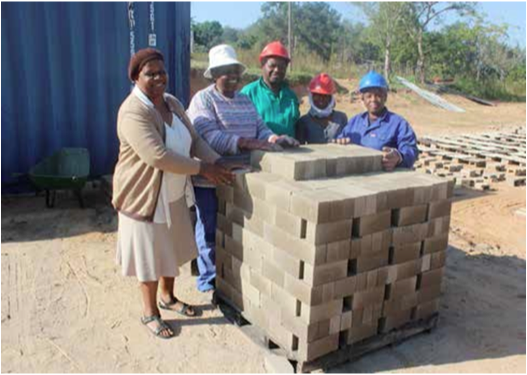 I realized that finding a job was difficult and I was not going any- where. I had been sitting at home for five years with no income and things were not looking good for my family.
I realized that finding a job was difficult and I was not going any- where. I had been sitting at home for five years with no income and things were not looking good for my family.
In 2005, I teamed up with six people and registered the Tfutfukani Bricks Cooperative.”
The cooperative is situated in Tekwane West. Mavuso said, they registered their business in 2005 but only became operational in 2008. “It took time to get the business off the ground because we were also looking for land to work from as well as funding.”
Tfutfukani Bricks Cooperative makes about 10 000 bricks daily which are sold to local builders. They also have an agreement with Build It, a building supply retailer. The cooperative has an agreement to supply the retailer with their bricks which are SABS approved.
Five members of the cooperative work full time in the factory. Six other community members are employed as casual workers.
In 2008, Tfutfukani approached the Mpumalanga Economic Growth Agency (Mega) who granted the cooperative R495 000 loan funding. Delta EMD a global supplier of electrolytic manganese dioxide donated an industrial brick-making machine to the tune of R550 000. Mbombela Municipality provided land and they signed a lease agreement.
“With the money we installed electricity and fencing around the area we are working from. We also bought a container for storage, repaired the brick making machine, cleared the land, bought a secondhand forklift and constructed a guard house.”
She said last year the cooperative also approached the National Development Agency for further funding of R941 719, which was used to buy material and a truck so business could run smoothly.
Maxwell Mathebula, the NDA provincial manager confirmed that his agency funded the cooperative and also ensured that members receive training in governance and financial management and controls.
“The cooperative agreement with the likes of Build It will ensure constant supply of bricks and ultimately generate profit to sustain their operations. The agreement will also ensure that they produce quality bricks. This relationship with Build It will give them an opportunity to work and compete with other local producers in the Mbombela Municipality,” Mathebula said.
A typical day at Tfutfukani starts at 7am and ends at 4pm in the afternoon. “We start with mixing river sand, building sand and cement to manufacture the bricks.”
The cooperative makes three types of bricks: hollow bricks used to make homes and walls, maxi bricks which are used mainly for RDP houses and stock brick used for paving on the roads.
Mavuso says the cooperative is doing very well, with room for growth in the future.
An excited Mavuso also points out another construction site not too far from their work station where a new school is being built.
“We approached the contractor to supply him with our bricks. He was happy to work with us. We are very excited that we will be part of the process of building the new school in our community.”
The cooperative plans to expand and also produce concrete stones.
“We have come a long way and we are very proud of our business,” concluded Mavuso.
The smart ID card is here!
The smart ID card is here! sadminSmart IDs
 1. What do I need to bring along when I want to apply for a new Smart ID Card?
1. What do I need to bring along when I want to apply for a new Smart ID Card?
If you are a South African citizen: Bring along your green barcoded ID. If you are a first time applicant: Bring along your birth certificate, proof of address and, in case of minors, must be accompanied by the parent/s. If you are a permanent resident of South Africa: Bring the green bar-coded ID already in your possession. If a first time applicant: Bring permanent residence certificate and proof of address.
2. How long does it take for an applicant to receive a Smart ID Card?
14 working days from date of application provided it is a straight forward application meeting all the requirements.
3. How does the Smart ID Card benefit citizens or the country?
It will help combat identity theft, fraudulent activities related to drivers licence, social grants, financial institutions as well as insurance.
4. How much will I pay for Smart ID Card?
The Smart ID Card will be issued free to the 16 year-olds who are first time applicants. All other Smart ID Card applicants will be expected to pay R140 - the same cost as the current green ID.
5. Will Smart ID Cards be delivered / couriered to citizens and permanent residents’ address of choice?
No, citizens [and permanent residents] will have to present themselves at the office where they applied to collect the card.
6. Will the Smart ID Card be used for 2014 Elections?
Citizens who have Smart ID Cards at the time of elections will use the Smart ID Cards for voting whilst those who don’t will use the green bar-coded ID Books to vote.
7. What will happen to the green ID when a citizen or permanent resident is issued with a New Smart ID card?
The Department will take back the green barcoded ID book to be cancelled in accordance to the Identification Act.
8. Will there be security on the Smart ID Card to prevent hacking?
Yes, there are high level security features.
9. Can a Smart ID Card be faked?
It is extremely difficult to either intercept or to duplicate the Smart ID Card.
10. What is going to be in a Smart Card?
The information that will be on the body of the card will be your names, gender, citizen’s status, your date of birth and your ID number.
11. How many photos/pictures am I expected to bring for a Smart ID Card and Passport application?
There will be no need for applicants to bring photos. The environment for the Smart ID Card will cater for both application processes.
12. Will all applicants walk out of their local Home Affairs office with a Smart ID Card immediately after application?
No, the Smart ID cards will be printed at a secure location and be delivered to the office of application.
13. What is the estimated time to be taken to phase-out the old green ID document?
An estimated period of 5 to 7 years, starting from 2013.
14. Will permanent residence permit holders also qualify to apply for the new Smart ID Card?
Yes.
15. Will SA citizens living abroad also have to apply for the new Smart ID Card?
All SA citizens and permanent residents will be required to have the new Smart ID Card.
16. If I do not remember my ID number and I do not have my green barcoded ID, will I still be able to apply for a new Smart ID Card?
Yes, you will still be able to apply but your application will follow a different process.
17. What happens if you lose the ID after you have applied for a Smart ID Card?
You have to provide proof in the form of a Police case number and affidavit. You will have to pay the prescribed fee for the new ID Card.
18. How will persons with limb disabilities apply for Smart ID Cards since the new system requires fingerprints?
Such persons will be issued with a pin code.
19. Will one be able to track process of the application with the DHA Call Centre?
Yes.
20. Will there be some special arrangements in place to assist persons in rural areas to apply for the Smart ID Card?
Yes, however in the initial phase, applications will only be lodged at 72 identified offices.
21. I suspect that someone else is using the same ID number as I. Will this be rectified if I apply for a new Smart ID Card?
No, if your ID number is indeed duplicated, visit a Home Affairs office. The duplication will be resolved first before you apply for a Smart ID Card.
22. I want to change my name/surname/date of birth/add a name. Can I do it at the same time?
No, you will first have to finalize any amendments and rectifications to your personal particulars before you can apply for a new Smart ID Card.
23. Who can apply for a Smart ID Card as from 18 July 2013?
The Department will invite applicants in a phased in approach. Full details of where and when members of public can start applying for Smart ID Cards will be published.
24. Will one be required to renew the Smart ID Card from time to time?
No, except when the card is damaged or lost.
25. I have already applied for a new bar coded ID and I am still waiting for it. Will I be issued with a smart ID card?
No, you will be issued with a green barcoded ID. The Smart ID Cards will be phased in over a seven year period and members of public will be advised when to apply.
26. I want to apply for a (new) SA passport. Do I first have to apply for a new Smart ID Card before I can apply for a passport?
No, you can still apply for a passport by producing your green barcoded ID.
27. I am already in possession of a Smart ID Card. If I get married or divorced and my surname changes, do I have to apply for a new Smart ID Card?
Yes, when one gets married and assumes another surname, it is strongly advised that one apply for a new Smart ID Card, at the required fee.
28. If one undergoes a gender change, will it be necessary to apply for a new Smart ID Card?
Yes, after the gender amendment has been finalized, you will be required to apply for a new Smart ID Card.

Xoliswa Bekiswa's ship has come in
Xoliswa Bekiswa's ship has come in sadminFor many years, Xoliswa Bekiswa had to share her mother’s measly salary of R2500 with her two siblings and four cousins.
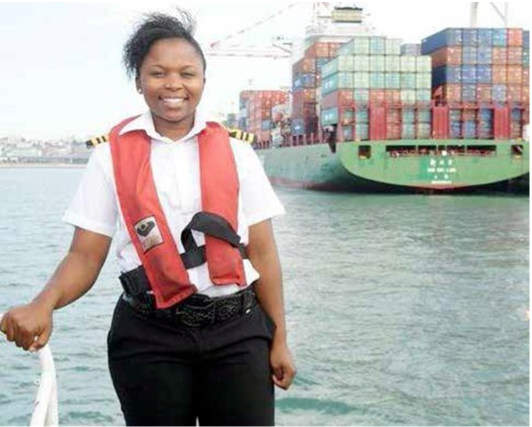 When her mother was retrenched a year before Xoliswa did her matric in 2000, the family was plunged into even more poverty.
When her mother was retrenched a year before Xoliswa did her matric in 2000, the family was plunged into even more poverty.
The 29-year-old from Flagstaff, 45km north of Lusikisiki in the Eastern Cape, wished she could sail away.
But in 2001, with a bursary from Transnet National Ports Authority (TNPA), she could pursue a one-year maritime studies programme to realize her dream. She then went on to complete her practical training as a cadet out at sea with Unicorn Shipping Line.After a one-year pilot training programme, she qualified as a junior pilot at the Port of Cape Town before progressing through the various licence grades, starting with smaller ships of around 16 000 gross tons, which she soon upgraded to 20 000, then 25 000 and 35 000 before she obtained an open licence at the Port of Ngqura.
Matomela joins an exclusive club of five female marine pilots in the country who are tasked with the demanding task of guiding anything from the very smallest vessels to the gigantic super tankers and container ships into port.
Her fascination with the sea began while she went on a school trip to the Grahamstown Science Festival when she was doing Grade 11 in 1999. There, she met an exhibitor who explained how the world of vessels works.
“On the last day of the excursion, I went to curiously investigate an exhibition with pictures of vessels and ship models. The exhibitor explained in detail the process, dynamics and benefits of choosing a career in the maritime industry and I was hooked immediately,” she said.
From the festival, she was on a mission to find out more about the world of vessels and she started digging more. “I started conducting research on my own. It was a bit difficult for me because information about the industry was not as readily available as it is today.”
Her admission to study for a Diploma in Maritime Studies at the Durban University of Technology in 2001, signalled the beginning of a new chapter in her life and brought her closer to her dream. Little did she know the challenge that awaited her in the first year of study.
As her mother was unemployed, she had to go through the first six months of her first year with two skirts and one jean that were donated by a family member. “It was a terrible feeling, having to wear the same clothes over and over again,” she recalls.
In 2001, Matomela’s determination saw her entering the male-dominated field. She says getting into the field was not difficult, but the difficulty comes in when you are expected to prove yourself.
“We had to work twice as hard compared to our male counterparts”.
After a compulsory oral examination with the South African Maritime Safety Authority (SAMSA), Bekiswa was awarded a Class 3 Desk Officer ticket to be a junior Deck Officer responsible for auto piloting vessels and man- aging safety equipment.
She then trained and worked as a tug master at the Port of Durban, directing ships in and out of the port with the aid of small tugboats. During all the hardships and the challenges, Bekiswa says she took valuable lessons from her mother and she will always be grateful to her. “I take the lesson learnt from my mother with me every day, that through patience, perseverance, strength and faith, anything is possible.”
Summit to create jobs in Ekurhuleni
Summit to create jobs in Ekurhuleni sadminWhen his contract with a ceiling manufacturing company ended three years ago, the 27-year-old Sthembiso Menaneso drew on his home baking skills to make a living. Together with his brothers, he started baking cakes to sell around their home in Katlehong. “Baking was what our mother had taught us so we decided to make money out of it.”
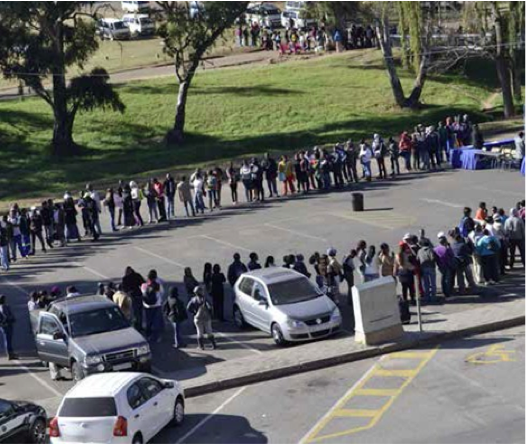 They baked cakes for weddings, funerals, corporate functions and other community events from their family kitchen. The brothers now want to register and grow the business into a catering company.
They baked cakes for weddings, funerals, corporate functions and other community events from their family kitchen. The brothers now want to register and grow the business into a catering company.
Menaneso is one of the 12 000 people from across the Ekurhuleni Municipality who attended the three-day Job Summit and Career Expo held by the Municipality at the Alberton Civic Centre to share the municipality’s perspective on stimulating youth development, job creation and skills development.
He says before attending the summit, he did not know where to go to register the business, how to draw a business plan and a company profile and where to access funding.
Menaneso says the summit opened his eyes and gave him access to information on how to grow the business and make it professional.
“I also learnt from the summit that as young people we should be the creators of jobs and not wait for jobs to come to us. There is always a second chance in life and we should use it.”
Ekurhuleni Mayor Mondli Gungubele said the city was committed to creating 180 000 jobs over five years.
Mayor Gungubele said to date over 500 young people have been placed on the City's Graduation Placement and Experiential Programme to gain work exposure over a period of 12 months.
He said unemployment in Ekurhuleni stood at 39.5 per cent.
“Of those people, 61 per cent are young people of 34 years and below. Moreover, 42 per cent of the population does not have a matric. Only three per cent of the population has a qualification equivalent to a university degree.”
He said this was worrying because it showed that nearly four out of every 10 young people are unemployed. He added that two out of four unemployed young people within Ekurhuleni are heading a household.
“It is against this background that a significant portion of our future plans revolve around creating jobs for young people.”
He called on the private sector to enter into partnerships with the city to create jobs and develop skills.
The city and various businesses in Ekurhuleni have committed over R10 million towards bursaries for post-secondary education and on-the-job training in line with the municipality’s “Window of Opportunity” initiative.
Mayor Gungubele said since June last year, the metro has implemented the second phase of the Contractor Development Programme where 20 learner contractors were implementing projects worth R47 million.
The Municipality’s Waste Management Services Department has appointed 149 young people as part of the youth work readiness programme.
The Ekurhuleni Metro Police Department implementing is also pilot project for 100 youth who are being trained as Peace Corps, which are, volunteers working with the community.
The Mayor said the Disaster and Emergency Management Services was implementing a Fire Brigade Reserve Force programme for 200 youth.
The metro has also developed the Ekurhuleni Business Support Centre in Kempton Park where SEDA and ABSA will jointly provide enterprise development support to youth owned businesses.
“Come this time next year, I will be reporting back to the community the progress we have made flowing from resolutions and commitments we have made at the summit,” he said.
Menaneso also vowed to return to the summit next year to access information and network with like-minded people.
Oyama lives her dream up in the sky
Oyama lives her dream up in the sky sadminYouth matters
It was over 10 years ago, during one of Oyama Matomela’ s Sunday afternoon strolls with her aunt to the Port Elizabeth Airport, that she fell in love with aircraft, and started dreaming of becoming a pilot.
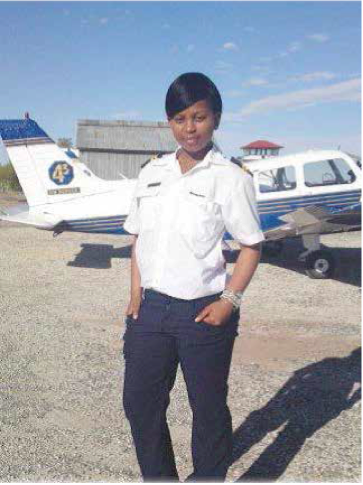 Matomela is now living her dream, but she says it was not easy learning to fly. “It was a challenging journey especially because this is a male-dominated field and as a woman you have to put in an extra effort.”
Matomela is now living her dream, but she says it was not easy learning to fly. “It was a challenging journey especially because this is a male-dominated field and as a woman you have to put in an extra effort.”
The 21-year-old is one of the more than 500 young people from the Eastern Cape who have benefited from the bursary scheme started 10 years ago by the Eastern Cape Department of Transport.
She is the fi female sponsored by the department to obtain a pilot licence. Now, after being appointed by a Johannesburg- based Superior Pilot Services to fly and instruct pilot students, she seems set to soar even higher.
“I started liking airplanes at an early age when my aunt took me to the Port Elizabeth Airport to see airplanes taking off and landing. I knew back then that I would one day become a pilot,” says the elated Matomela. In 2012, she completed her studies and obtained her pilot’s licence with the internationally acclaimed 43 Air school. For her pilot licence, she had to attend theoretical classes, write eight exams and do practicals within a space of eight months.
She recently completed her Grade 3 Instructor Rating Course in Aviation at the 43 Air School which allows her to instruct student pilots. “I feel good about getting the job, but I still need to do the 15 hours of flying the Cessna 172,” she explained.
The department has pledged to assist Matomela get her 15 hours of flying the Cessna 172. “We have come a long way with Oyama and she has always shown commitment to her studies. We just can’t let her down now,” said the department’s Human Resource Development Manager, Linda Bovana.
When asked where she sees herself in the future Matomela’s answer is firm. “Flying for South African Airways or South African Express.”
Last year she appeared in a television advert for Brand South Africa’s new slogan “Inspiring New Ways”, where she featured alongside several prominent South Africans including celebrities, sports stars, entrepreneurs and entertainers.
The MEC for Transport in the Eastern Cape, Thandiswa Marawu, said her department is proud of Matomela’s achievement. “We salute this young lady who worked very hard in a male dominated environment and made full use of the opportunity she was offered by the department through our bursary scheme.
“As a department, we are proud of her and we truly believe that her achievement could serve as an inspiration to other young ladies in the province.”
BP pumps up the performance of learners in rural areas
BP pumps up the performance of learners in rural areas sadminYouth matters
Learners doing Grades 10, 11 and 12 from rural schools in Limpopo, Mpumalanga and Gauteng are set to benefit from a multimillion investment by oil company BP.
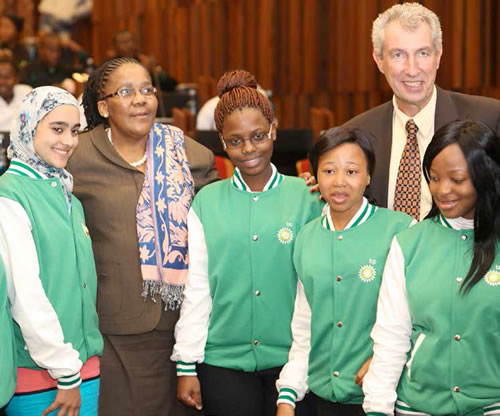 The petroleum giant BP has invested R105 million in a youth development programme to support government plans to empower young people, especially those from disadvantaged backgrounds. The programme runs from 2013 to 2018.
The petroleum giant BP has invested R105 million in a youth development programme to support government plans to empower young people, especially those from disadvantaged backgrounds. The programme runs from 2013 to 2018.
The programme is run by Wits University during school holidays, with students from the three provinces coming to the campus to attend lessons.
From this year, the investment will see more than 900 learners from rural schools in the three provinces take part in a programme designed to bridge the gap between high school and university and to create a pool of skilled young professionals who will contribute to the growth of the economy and take the country forward. The Targeting Talent Programme aims to counter possible negative influences such as a lack of rigorous curriculum, poorly trained teachers and the absence of successful role models in rural communities. The programme works with the learners over a three year period (Grades 10, 11 and 12) to increase their academic, social and psychological preparation for admission to and success at select South African universities. The three year preparation includes academic enrichment , personal development skills, educator development and intensive mathematics and science curriculum.
The programme has achieved an incredible success rate to date. Learners who participated in the programme in 2010 and 2011 include Ngoanapedi Mmadikgetho Komane who was named last year’s top national matriculant.
Since the programme started in 2010, 199 learners have participated with 192 successfully matriculating. Most of them are currently studying at tertiary institutions.
BP Chairperson Thandi Orleyn is delighted with the programme. BP has contributed R4.5 million towards the project. “Having been a sponsor of the project since its inception in 2010, we have been consistently impressed by its results, which is why we have undertaken to make the initiative BP South Africa’s flagship corporate social responsibility venture for the next decade.
“The programme is a clear demonstration of BP’s part to actively contribute to the country’s national growth and economic development,” says Orleyn.
Then Minister of Energy Dipuo Peters applauded BP’s commitment to the project and said it was a step in the right direction to bring about sustainable and meaningful transformation in the liquid fuels industry.
“We expect that corporate South Africa plays a major role in the transformation agenda, and this initiative is an instructive example of how businesses can drive a concerted effort to develop, nurture and sustain black executive talent, targeting especially the youth,” said Peters.
Madiba magic brings out the best in South Africans
Madiba magic brings out the best in South Africans sadminNelson Mandela Day
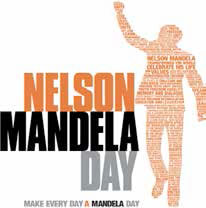 The spirit of giving and unity was in the air as South Africans from all backgrounds made time to do acts of kindness for less fortunate members of society. It was Nelson Mandela Day - a birthday of the first democratically elected President of South Africa - a day when people get out of their uniforms and suits to put on t-shirts, overalls and jeans - ready to serve.
The spirit of giving and unity was in the air as South Africans from all backgrounds made time to do acts of kindness for less fortunate members of society. It was Nelson Mandela Day - a birthday of the first democratically elected President of South Africa - a day when people get out of their uniforms and suits to put on t-shirts, overalls and jeans - ready to serve.
Armed with paint brushes, spades, brooms and other tools, they sweated, making the environment beautiful, feeding the hungry and feeling hearts with joy.
For 67 minutes and more, they laboured, sprucing up floors, removing rubble, painting walls and faces, giving out food parcels, cooking and feeding the hungry.
At the end of the day, there was happiness all round.
This was Madiba Magic at play. A day when South Africans led the international community in performing acts of generosity.
Children’s homes, schools, old age homes and orphanages were left cleaner and brighter and needy children treated to delicious meals.
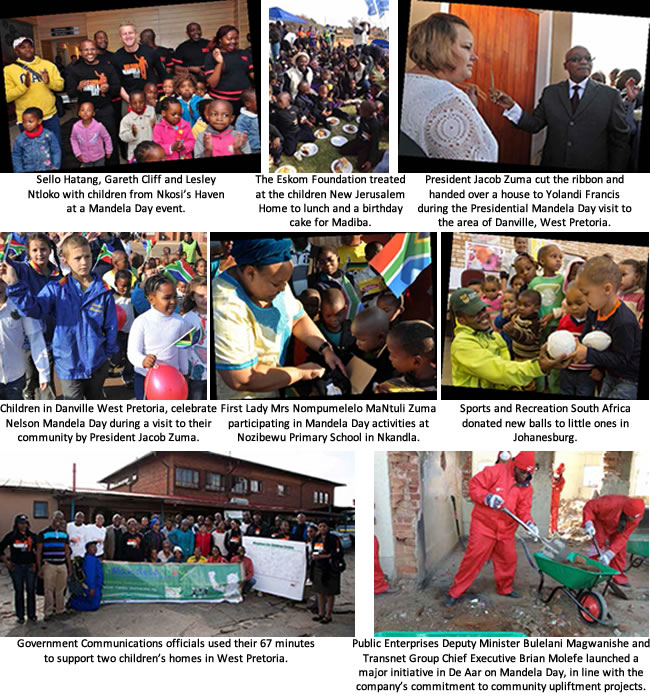
More communities get to hear and see themselves in the media
More communities get to hear and see themselves in the media sadminThe people of Soweto can today switch on their television sets to watch people they know, in familiar surroundings, addressing issues specific to their communities in languages they speak.
 Since the advent of Soweto TV, the community has been able to watch programmes with local content and interact with the station through its community outreach programmes.
Since the advent of Soweto TV, the community has been able to watch programmes with local content and interact with the station through its community outreach programmes.
Unlike Commercial TV stations, Soweto TV is not out to make money, but to uplift the community. Marketing Manager at the station Jonathan Ramotsei says they are running long-term projects every month across different sections of Soweto. “We run a Community Project called Making a Difference. This is a project that tackles social challenges facing the community of Soweto. We also run a learnership programme that is aimed at developing television skills in most of Soweto.”
The growth of Soweto TV results from efforts to diversify the local media landscape. It is part of efforts by the Media Development and Diversity Agency (MDDA) to encourage community media. Lumko Mtimde, CEO of the MDDA, says the growth of community media in the country gives life and meaning to the Constitutional rights of freedom of expression and access to information enshrined in the Constitution.
Since it was set up in 2003, the MDDA, in partnership with various institutions, has launched a variety of initiatives to promote and support the development of new media.
Speaking at a recent conference to celebrate a decade of community media, Minister in the Presidency for Monitoring and Evaluation Collins Chabane said government’s aim of supporting MDDA was to ensure that there is transformation in the ownership of media in the country.
“Government’s interest in the media trans- formation process is to ensure that the media sector develops and transforms from within, in order to contribute to the broader development of society and economy.
“Government's interest is also to have a financially viable and sustainable community media which is very important in achieving real media diversity in our country. The voices of our communities rely more on this platform than in the commercial press which is mostly reflective of the voices of those who have money to buy advertising space or the newspaper.”
Mtimde says since it was established, the MDDA has allocated grants totalling R239 million to 487 projects. A total of 2021 people have been trained and 247 bursaries have been provided to different radio and print media.
Though the community media landscape has changed in the past ten years, and significant strides made, the journey has been tough, as explained by Tshepo Thafeng, founder of Soweto TV.
“It has been tough, very tough especially for community TV. When community radio was mushrooming community television was also introduced. But when you applied for a com- munity TV licence, there were no applications for that”.
The absence of TV licence applications forced the Soweto TV to apply for a radio licence and broadcast with a radio licence instead. According to Thafeng, Independent Communication Authority of South Africa (ICASA) did not issue TV licences at first. “It was only after 2006 that community television license was granted.”
Thafeng’s sentiments were echoed by Mafisa FM (Rustenburg) founder Kopano Molefe, who also said it was tough setting up a community radio station. “It has been a difficult journey in the sense that we were getting into something that we didn’t know. We didn’t understand the challenges we would have to deal with, especially the relationship between community media and government”. He adds though that as the process unfolded, the two parties began to find common ground and he is hopeful that things will improve for the better.
With operators now getting to grips with the system and communities getting used to and supporting the new local players in the field, the future looks bright for community media.
President Jacob Zuma appoints new Ministers
President Jacob Zuma appoints new Ministers sadminPresident Jacob Zuma has beefed up the National Executive by appointing three new Ministers and four Deputy Ministers.
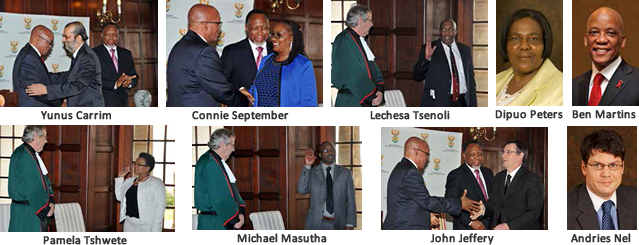
When President Jacob Zuma introduced the incoming members of the National Executive he said that 20 years of democracy have changed the face of our country, and the last five years have pushed that change forward. The achievements are due to the hard work of many of our Ministers, Premiers, Deputy Ministers, MECs, Mayors and many others who have worked hard in leading the process of transformation and improving the quality of life of our people - to take that change forward, President made some changes to the National Executive.
Former Deputy Minister of Rural Development and Land Reform Mr Lechesa Tsenoli has taken over from Mr Richard Baloyi as Minister of Cooperative Governance and Traditional Affairs.
Communication also sees a change with Mr Yunus Carrim coming into office. Human Settlement comes under the leadership of Ms Connie September who replaces Mr Tokyo Sexwale. Former Transport Minister Mr Ben Martins has moved to Energy and Ms Dipuo Peters moves to Transport.
The President also appointed four new Deputy Ministers. Mr John Jeffery takes over from Mr Andries Nel at Justice and Constitutional Development. Deputy Minister Nel has moved to Cooperative Governance and Traditional Affairs.
Mr Michael Masutha takes over as Deputy Minister at Science and Technology, and Ms Pamela Tshwete will be the new Deputy Minister of Rural Development and Land Reform.
“We thank the outgoing Ministers for their contribution in taking the work of government forward and creating a better life for all. We wish all incoming members of the National Executive all the best in their new portfolios,” said President Zuma.
Meanwhile, Mr Stanley Mathabatha has been appointed as new Premier of Limpopo. The new Premier appointed eight new Members of the Executive Council (MECs).
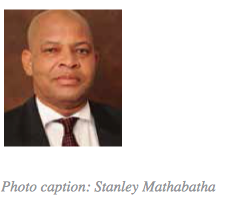 The new Limpopo MECs are:
The new Limpopo MECs are:
- Public Works: Namane Masemola
- Agriculture: Rosina Semenya
- Health and Social Development: Dipuo Letsatsi-Duba
- Sport, Arts and Culture: Merriam Ramadwa
- Provincial Treasury: Rudolf Phala
- Roads and Transport: Lehlogonolo Masoga
- Economic Development Environment and Tourism: Seaparo Sekoati
- Co-operative Governance and Human Settlement and Traditional Affairs: Ishmael Kgetjepe
Government makes it easier for beneficiaries to get maintenance money
Government makes it easier for beneficiaries to get maintenance money sadminThe Department of Justice and Constitutional Development is on a mission to get defaulters to pay maintenance and to make it easier for beneficiaries to get the money.
With its new Kha ri Unde campaign, the department will pursue people who fail to pay maintenance with more vigour.
It will also put systems in place to make it easier for beneficiaries to apply for maintenance and get their money on time.
The campaign, which means ‘let us pay maintenance’ in Tshivenda, is being piloted in nine courts across the country. So far, 50 Maintenance Officers, 18 Data Capturers and 30 Maintenance Investigators have been hired and are undergoing training at the pilot sites. Once all pilot sites have undergone final inspections, the Kha ri Unde campaign will be implemented nationally to all courts and sites over the next three years. The project has also improved systems at the pilot sites, including the managing of queues; an application desk; an investigation desk; a process desk and a mediation desk.
According to Advocate Mable Khoza, Legal Administration Officer responsible for maintenance in the Promotion of the Rights of Vulnerable Groups (PRVG) Unit, “the department identified an urgent need for a more comprehensive, all embracing and long-term initiative aimed at addressing the current systemic inefficiencies that delay service delivery in maintenance.”
To help reduce the time it takes to pay maintenance money to beneficiaries, the department introduced a decentralised Electronic Funds Transfer (EFT) payment system in 301 courts country-wide.
“This has reduced the payment of maintenance money to under 48 hours after allocation by the courts, where previously, beneficiaries would wait for payment for up to 14 days”, said Nico Van Harmelen, Director responsible for Third Party Funds (TPF) Management.
Haremelen added that the department was in the process of rolling out the new EFT sy tem to the pilot court sites.
The department is also looking at the possibility of getting employers to pay maintenance money directly into the accounts of beneficiaries once a court has granted an order.
This way, says Advocate Khoza, the beneficiary can only approach the court to lodge a complaint when there is a default, in which case a warrant of arrest can be issued or property attached.
The new Kha ri Unde pilot project follows the department’s previous maintenance campaign called Operation Isondlo. Launched in December 2005, the project made great strides in tracing unclassified accounts, issuing warrant of arrests together with the police on maintenance defaulters, and worked together with provincial transport departments to apprehend defaulters during routine roadblocks.
Department of Justice and Constitutional Development: 012 315 1856/4
Johannesburg impresses mayors of the world
Johannesburg impresses mayors of the world sadminGlobal transport experts who conducted a compre- hensive peer review of Joburg’s Bus Rapid Transit (BRT) system have described it as “simply world-class”.
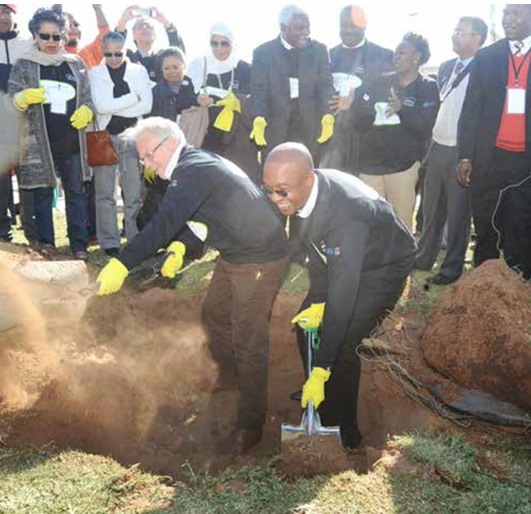
They were in town to attend the Metropolis Annual Meeting, a four-day gathering which attracts 150 participaties cities that have at least one million residents each.
The gathering in Sandton attracted mayors, officials and leaders from more than 80 cities around the world to discuss ways of enhancing urban development and improving the lives of urban residents.
Under the theme of "Caring Cities", delegates exchanged best practice on various aspects of urban development; focusing on topics such as rapid urbanisation, food security, informal economy, women’s network, safety and security, funding models, caring cities, building social cohesion and greater citizen involvement for growing cities.
The Metropolis meeting sets global benchmarks, conducts peer reviews and is involved in a range of city-related develop- mental issues.
The meeting was being hosted in Africa for the first time since the establishment of the network in 1985.
The City of Johannesburg used the forum to share its experience in developing the BRT system, which has tremendously improved public transport in the city. Mayor, Parks Tau said the project was implemented in phases, with each phase getting cheaper and easier to implement.
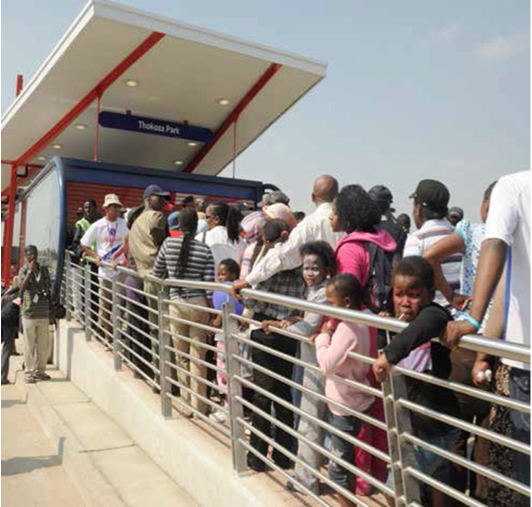 The team of experts that inspected the Joburg BRT system included Hanns-Uve Schwedler of the European Academy of the Urban Environment in Germany, Professor Paul James of the Global Cities Research Institute in Australia, Dr. Desmond Amiegbebhor Edenojie of the Lagos Metropolitan Area Transport Authority in Nigeria, Guillermo Calderon Aguilera who is the General Director of Metro Bus in Mexico, Professor Abhijit Lokre who heads the faculty of planning and public policy in CEPT University in Germany and Barbara Berninger of Metropolis.
The team of experts that inspected the Joburg BRT system included Hanns-Uve Schwedler of the European Academy of the Urban Environment in Germany, Professor Paul James of the Global Cities Research Institute in Australia, Dr. Desmond Amiegbebhor Edenojie of the Lagos Metropolitan Area Transport Authority in Nigeria, Guillermo Calderon Aguilera who is the General Director of Metro Bus in Mexico, Professor Abhijit Lokre who heads the faculty of planning and public policy in CEPT University in Germany and Barbara Berninger of Metropolis.
They gave the system a resounding "10 out of 10", but warned that challenges may arise as the system expands.
James was impressed by the system, saying "mechanically, from the training side to construction and infrastructure - it is an exemplary system… It deserves a 10 out of 10 for what it has achieved thus far". Another panel member, Schwedler, said "to have such a system in a short time in a non-democracy is impressive. In Germany something like this would have taken ten years to get off the ground".
The BRT system was set up in 2009 and covers over 25km, primarily between Soweto and the Johannesburg city centre, and has an average of 42 000 passengers a day. In October it will be increased by a further 18km while other phases will also be introduced in time.
"The next phase of the BRT will see improvements as a result of our own lessons and the experiences we shared with our colleagues and peers internationally," Mayor Tau said. Metropolis Secretary-General Alain le Saux was impressed with Joburg’s hosting of the event. "Good event organisation, high level of discussion and top jazz at the function!"
Mitchell’s Plain gets into shape with hope
Mitchell’s Plain gets into shape with hope sadminSport, arts and culture
South Africa is set for a massive boost in science with the recent announcement that the country – together with eight African partner nations – will host the majority of the Square Kilometre Array (SKA) telescope project.
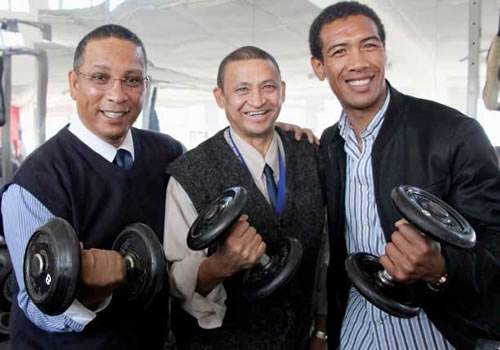 Schoolgoing kids are lining up along- side their parents and grannies to do aerobics, lift weights, run on a treadmill and do bench presses.
Schoolgoing kids are lining up along- side their parents and grannies to do aerobics, lift weights, run on a treadmill and do bench presses.
This wave of fitness fanaticism sweeping through the community was started by government and gym clubs.
Spearheaded by the provincial Department of Cultural Affairs and Sport (DCAS), together with Virgin Active South Africa and the Greensmile Foundation, the fitness campaign has established a gym at a local high school, built a brand new gym in the community and hosted mass community aerobic sessions.
The campaign is another example of government joining forces with the private sector, as part of the Public Private Partnership, to create better opportunities for communities in need. The fitness campaign is part of Virgin Active’s Future Crew project aimed at transforming and creating healthier communities around the country.
A healthy education
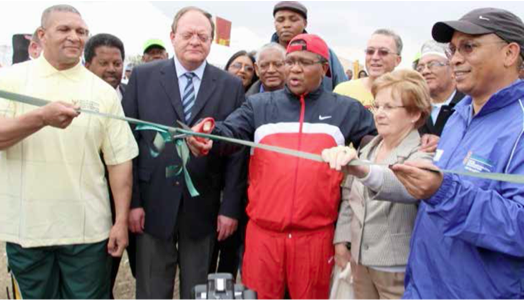 Learners at the Bishop Lavis High School in Cape Town are now more alert in the classroom and pay more attention to their work, thanks to the new gymnasium opened at their school.
Learners at the Bishop Lavis High School in Cape Town are now more alert in the classroom and pay more attention to their work, thanks to the new gymnasium opened at their school.
Launched by the provincial Minister of Cultural Affairs and Sport Dr Ivan Meyer recently, the new gym gives learners easy access to a quality fitness facility. The overall goal of the school health project is to involve learners in exercise to help them learn new skills and to enable them to participate in a mentoring programme headed by qualified sports and life skill coaches.
The project highlights sport as an integral part of a healthy lifestyle and helps to combat increasing levels of obesity amongst South African youth. “The installation of this gym is a culmination of two years of planning, research and training and an opportunity to invest in the future of our country – our youth,” said Ross Faragher-Thomas of Virgin Active.
“Virgin Active has given the learners of Bishop Lavis High School a kick start towards living a healthy lifestyle. The youth have been given an alternative to the social ills that they see around them,” said provincial Minister Meyer.
The school also forms part of the Western Cape Government’s Mass participation, Opportunity and access, Development and growth (MOD) programme. The programme has to date established 181 MOD centres at schools across the province which provide sport and recreational activities in a safe environment to disadvantaged communities and underprivileged learners.
According to Principal Kevin Sonn, the new fitness approach will also assist his goal of increasing the school’s matric pass rate up from 63% in 2012 to 75% in 2013. “This partnership with the school, the department and Virgin Active will provide important support to learners already participating in athletics, cross country, netball, cricket, rugby as well as dance. We believe there is a strong correlation between physical activity and academic performance,” said Sonn.
Community gym, a beacon of hope
To extend the fitness campaign to the community, residents of Mitchells Plain are now able to enjoy the fun of exercising with the community’s new outdoor gymnasium. Built in Rocklands, Mitchells’s Plain, the new gym was recently opened by Sport and Recreation South Africa (SRSA) Minister Fikile Mbalula. The new facility was a joint project by SRSA and the Western Cape provincial department of Cultural Affairs and Sport and the City of Cape Town. The new gym, built by World Outdoor Fitness, uses low-cost equipment which means that it is less likely to be stolen or vandalised.
Provincial Minister Meyer said the new facility would restore hope to the community, defining HOPE as Higher Opportunities for People to Excel.
“This is a great project that will benefit the community, in particular the children, and will instill a sense of pride among residents. This new venture will create a socially inclusive, active and fit community.”
To intensify the new fitness campaign, the new gym recently held a mass public aerobics session with over a hundred community members and residents lining up to get fit.
Residents joined along, kitted out in their sports gear, chanting the words “lekker lekker” as they maneuvered between exercises. “It is really nice to see a whole community exercising together. This encouraged them to enjoy the session and at the same time, motivated them to engage in a fun and relaxed type of exercise,” said gym official Olivia Carolisen.
Twelve year old Caithlin Prins of Spineview Primary said she felt good after the session. “To exercise with people from my community was fun, it was funny exercising with senior citizens but we enjoyed it,” she said.
SA rugby, soccer unite for Nelson Mandela Sport and Culture Day
SA rugby, soccer unite for Nelson Mandela Sport and Culture Day sadminSport, arts and culture
South Africa will be treated to a sporting and cultural showcase when the Nelson Mandela Sport and Culture Day takes place at FNB Stadium on 17 August, all in aid of the Nelson Mandela Children's hospital project.
 For the first time in history, both the Springboks, who will be playing Argentina, and Bafana Bafana who'll be taking on Burkina Faso, will play on the same field on the day.
For the first time in history, both the Springboks, who will be playing Argentina, and Bafana Bafana who'll be taking on Burkina Faso, will play on the same field on the day.
But there'll be plenty more to keep fans entertained on the day. A South African masters football side will be taking on Italy, while a music concert in the evening will feature the best of South African talent.
Speaking at the launch of the event at a function in Johannesburg attended by a veritable who's who of sport in South Africa, Minister of Sport and Recreation Mr Fikile Mbalula said the day was a celebration of the contribution Nelson Mandela made through sport, especially during his term as President of South Africa. It is in the spirit of this that all proceeds from the Nelson Mandela Sport and Culture Day will be in aid of the Nelson Mandela Children's Hospital project.
All speakers at the event acknowledged Mandela's ill health and wished him well. The high esteem he is held in by all sportspeople both locally and internationally was evident both from comments as well as clips from a video highlighting the many meetings Mandela has had with famous sportspeople through the years, and remarks he has made regarding the important role of sport in the community.
Minister Mbalula also acknowledged the achievements of two current sport greats, national hockey side captain Marsha Cox, who has scored 300 goals and Springbok hero Brian Habana, who has scored 50 tries during his Springbok career.
Marsha received a Fiat 500 car as a reward and Habana a cheque of R50 000, which he promptly donated to the Nelson Mandela Children's fund.
The project is a collaboration between stakeholders including the South African Rugby Union, South African Football Association, SRSA and the Department of Arts and Culture, with many smaller partners and sponsors also playing a role. It is coordinated by SRSA, who is also contributing financially.
Tickets to the event start at R220 and is available from Computicket.
Source: Sports and Recreation South Africa